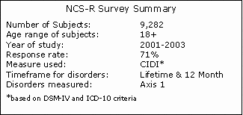The DRAM, Vol. 1(11) – Alcohol use disorders and psychiatric comorbidity
SPECIAL SERIES: COMORBIDITY ACROSS THE COUNTRY
This review is the second in a series of five issues of the BASIS featuring the most recent research on comorbidity among psychiatric and addictive disorders. Last week, WAGER 10(12) discussed findings from the National Epidemiological Survey on Alcohol and Related Disorders about pathological gambling and comorbid psychiatric and personality disorders. This week, The DRAM discusses findings from the National Comorbidity Survey Replication on the comorbidity of alcohol use disorders and other psychiatric disorders.
Alcohol Use Disorders and Psychiatric Comorbidity
The comorbidity of alcohol disorders with other psychiatric disorders can pose difficult challenges to health care providers. Epidemiological studies have evidenced the common psychiatric disorders that tend to be associated with alcohol abuse and dependence. In this week’s DRAM, we review a recent epidemiological study (Kessler, Chiu, Demler, & Walters, 2005) that assessed the prevalence and comorbidity of alcohol abuse and alcohol dependence among the adult population in the United States.
The National Comorbidity Survey-Replication (NCS-R) conducted face-to-face interviews with a sample of 9,282 non-institutionalized adults between February 2001 and April 2003. The survey used the World Health Organization World Mental Health Survey Initiative version of the Composite International Diagnostic Interview (CIDI), which generates diagnoses according to International Classification of Disease, 10th Revision and DSM-IV criteria. The survey asked questions about risk factors, consequences and other correlates of mental disorders among those participants who met lifetime criteria for any disorder (n = 5,692). The researchers considered alcohol abuse a stage in the development of alcohol dependence and therefore reported diagnoses for alcohol abuse with and without alcohol dependence. In addition to lifetime diagnoses, researchers also assessed the twelve-month prevalence of anxiety disorders, mood disorders, impulse control disorders, and substance abuse disorders.
Among the sub-sample who met lifetime criteria for any disorder (n = 5,692), the twelve-month prevalence of alcohol abuse (with or without dependence) was 3.1%; the twelve-month prevalence for alcohol abuse with dependence was 1.3%. Twelve-month comorbidity among participants with alcohol disorders was assessed using tetrachoric correlations among a sub-sample of 18 to 44 year olds1 (n=3,199) with lifetime disorders (see Figure).

Figure. Tetrachoric correlations between past 12-month DSM-IV alcohol use disorders and other past 12-month psychiatric disorders (adapted from Kessler, Chiu et al., 2005). * = other psychiatric disorder significantly correlated with alcohol use disorder at p < 0.05. Click image to enlarge.
These findings suggest that other substance disorders, mood disorders, and anxiety disorders are commonly associated with alcohol disorders. This finding is consistent with the previous results of lifetime comorbidity of mental disorders with DSM-III-R alcohol abuse and dependence from the original National Comorbidity Survey (Kessler et al., 1997).
Two limitations are noticeable in this study. First, the precise temporal sequence of alcohol disorders and other psychiatric disorders cannot be established from the cross-sectional study design. The findings about comorbidity provide little information on the causal mechanism of comorbid disorders, although some evidence from the current and previous National Comorbidity Survey (Kessler, Berglund, Demler, Jin, & Walters, 2005; Kessler et al., 1997) showed that alcohol disorders were usually reported as having a later onset age than at least one other psychiatric disorder. Using a 12-month time frame might not be sufficient to illuminate the causal sequence of comorbid psychiatric disorders. Second, the sample is not representative of some important sub-populations, including people with mental illness, homeless people, people in treatment, or linguistically isolated people. As a result, the prevalence estimates of alcohol disorders could be conservative. The possibility of under-reporting mental illness might exist among the general population, also leading to conservative estimates.
In sum, the National Comorbidity Survey Replication shows that alcohol disorders tend to be associated with other drug disorders, mood disorders and anxiety disorder within a 12-month time frame. This finding suggests that prevention and treatment efforts directed toward alcohol disorders pay special attention to other psychiatric complications because patients with alcohol-related problems often experience co-occurring disorders.
—Ziming Xuan
What do you think? Please use the comment link below to provide feedback on this article.
Notes
1. Kessler et al. only assessed 12-month comorbidity in the subsample of participants between the ages of 18 and 44 because “childhood disorders were assessed only in that age range” (Kessler, Chiu et al., 2005, p. 619).
References
Kessler, R. C., Berglund, P., Demler, O., Jin, R., & Walters, E. E. (2005). Lifetime Prevalence and Age-of-Onset Distributions of DSM-IV Disorders in the National Comorbidity Survey Replication. Archives of General Psychiatry, 62(6), 593-602.
Kessler, R. C., Chiu, W. T., Demler, O., & Walters, E. E. (2005). Prevalence, severity, and comorbidity of 12-month DSM-IV disorders in the National Comorbidity Survey Replication. Archives of General Psychiatry, 62(6), 617-627.
Kessler, R. C., Crum, R. M., Warner, L. A., Nelson, C. B., Schulenberg, J., & Anthony, J. C. (1997). Lifetime cooccurrence of DSM-III-R alcohol abuse and dependence with other psychiatric disorders in the National Comorbidity Survey. Archives of General Psychiatry, 54, 313-321.
